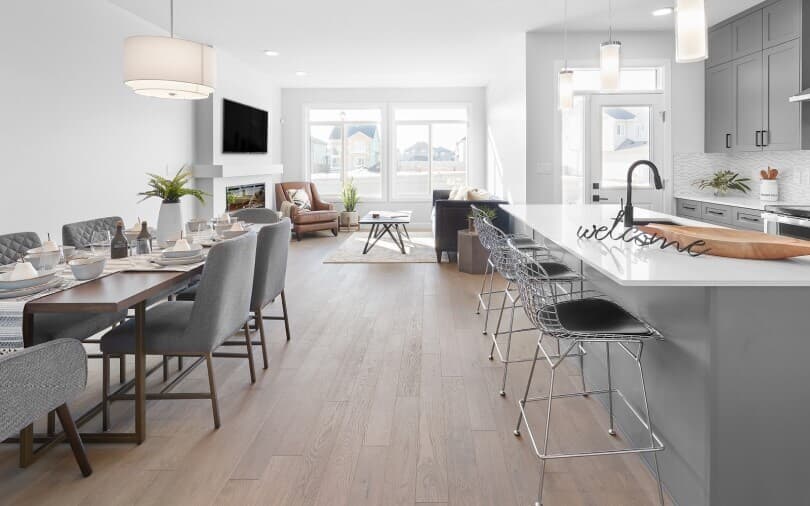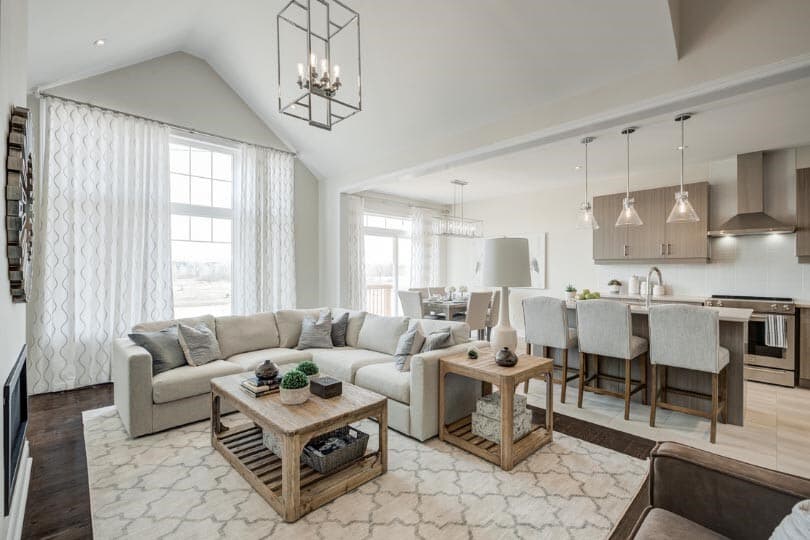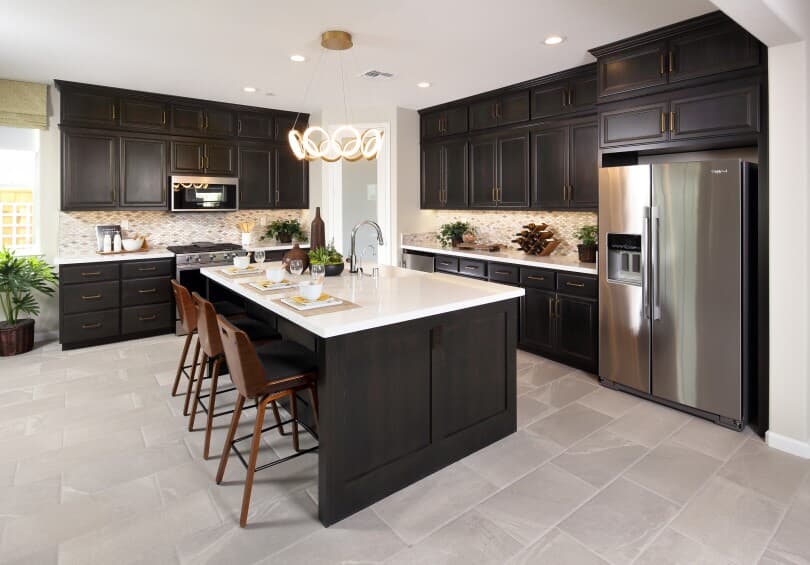Is it OK to Use Different Flooring Throughout Your House?

A common questions homeowners have is: “Should the flooring be the same throughout our home?” There are pros and cons to using the same material in your whole home, and it’s ultimately dependent on your personal preferences and the way your household lives.
To help you decide if the flooring should be the same throughout your home, we’ve put together some pros, cons, and things to consider before making a decision.

Pros of Uniform Flooring
1. It keeps the house looking consistent
If you have a color scheme or style that you love, having the same flooring flow from room to room will allow you to extend that feel throughout your entire home. Using the same flooring material ensures your home will have an elevated and cohesive design.
2. Your spaces feel larger and airy
Uniform flooring really makes a statement in an open concept floor plan. Your eyes can take in the entirety of the space rather than being distracted by breaks in the flooring. Your guests won’t notice the beautiful view as quickly if their eyes are drawn to the transition between the kitchen tile and the dining room hardwoods.
3. Cleaning and maintenance become easier
If you have just one flooring material, you don’t need different types of cleaning materials and techniques. If you opt for a low-maintenance product like luxury vinyl, cleaning is a breeze compared to the work of shampooing carpet.
4. It can be budget-friendly
Depending on your material choices, buying in bulk can be less expensive than buying several different types of flooring in smaller quantities. This may not be true in all scenarios, but it’s worth pricing out your options if you’re trying to stay within a budget.
5. Reduced risk of tripping
Different materials have different thicknesses. Hard materials typically have a lower profile while carpet has more plush and height. If there’s a more pronounced difference between two materials, there’s an increased chance someone could trip.

Cons of Uniform Flooring
1. Limited flooring choices
Not every material will work in every room. Tile may feel too harsh in a bedroom and carpet in a bathroom is a trend we don’t want to revisit. Finding flooring that will work in every single space may feel challenging and you don’t want to settle for something you don’t quite love.
2. It may feel basic
Having uniform flooring throughout your home doesn’t leave much room for creativity and uniqueness. If you’re more artistic or a design risk-taker, you may want a fun accent tile in the bathroom or a trendy mosaic in the laundry room. If you prefer to be bold, consistent flooring may feel boring.
3. It doesn’t always work with every decorating style
The light and bright flooring you love in your living area may not work in your dark and moody home office. Hard surface flooring may not feel right if you want a cozy vibe in the bedroom. Different color flooring can create different feelings for each room and having a uniform style may feel limiting.
4. Replacements can be challenging
Transition strips create a break in material so that if a room has damage to the flooring, you only need to fix that room. If the flooring is continuous, you risk a domino effect of having to redo more flooring than expected if you ever have an issue.

Things to Consider
If you’re still on the fence about whether the flooring should be the same throughout your house, here are some things to consider:
1. The layout of your home
If you have an open concept floor plan, a single flooring material will look more cohesive. The continuity will make your home appear even larger. If your home has a closed layout with each room having its own defined space, you can customize each space to have its own personality.
2. Your home’s architectural design
First and foremost, your home should be a reflection of your personal style. It should also make design sense; a modern farmhouse may look odd with Spanish tiles, just as an Italian-style villa would feel mismatched with an ultra-modern concrete floor. Staying true to your home’s architectural design will always pay off.
3. The climate
The climate probably isn’t that high on your list of things to consider when choosing flooring, but it should be! Damp and humid weather can shorten your hardwood’s lifespan and run the risk of warping. Carpet is a cozier option for colder climates just as tile or stone may be cooler in warmer environments.
4. Your household & lifestyle
Don’t underestimate wear and tear on your flooring. If you’re dreaming of real hardwood, but have kids or pets, it might not be a match made in heaven. There are plenty of more durable alternatives to traditional hardwood that may work better. If anyone in your household has asthma or allergies, it’s better to stay away from carpet as it can trap dirt and dust more easily. Carefully consider how your family lives, the stage of life you’re in, and what will be best suited to handle it all.
5. Your budget
Unless you have an unlimited budget, you need to calculate how much you’re willing to spend on both material and installation if you’re not putting in the flooring yourself. $2 – $5 per square foot is the sweet spot for many types of flooring. You can find some domestic solid hardwood and engineered wood flooring, but don’t expect much rare or imported woods. More attractive laminates and higher-quality luxury vinyl also fall in this price range.
If you’re looking to save on material costs, you can find lots of gorgeous ceramic and porcelain tile in the $2.00-or-less per square foot range, but with a more labor-intensive installation, the overall savings may be a wash.
Rare or imported hardwoods and engineered wood options like Brazilian cherry or mahogany will cost you $5.00 or more per square foot. The highest quality premium laminate and luxury vinyl flooring products will also be at this price point.

If you’re a fan of one type of flooring and want to use it throughout your home, go for it! Nor is there anything wrong with using different flooring materials in one house. Choosing your flooring is a big decision and the goal is to be happy with it for years to come.
Be sure to check out the Brookfield Residential blog for more design advice, homebuying insights, mortgage tips, and more. Explore where we build and connect with our sales team when you’re ready to learn more. We’ll be expecting you!
